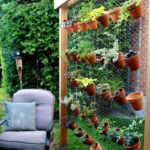Are you looking to add a unique touch to your garden? Look no further than gardening pallet ideas. Pallets can be transformed into versatile and eco-friendly gardening solutions that not only enhance the aesthetics of your outdoor space but also promote sustainability. From vertical gardens to raised beds, the possibilities are endless when it comes to using pallets in your garden.
Gardening with pallets opens up a world of creative possibilities for both novice and experienced gardeners alike. Not only are pallets cost-effective, but they also provide a sustainable alternative to traditional gardening materials. By exploring the potential of pallets in gardening projects, you can elevate your outdoor space while minimizing your environmental impact.
In this article, we will delve into the many benefits of using pallets in your garden, explore the different types, sizes, and materials of pallets suitable for various projects, and provide practical tips on preparing pallets for gardening. Whether you’re interested in creating a vertical garden, raised beds, or potting benches, this guide will help you navigate the world of gardening with pallets and inspire you to unleash your creativity in transforming your outdoor oasis.
Benefits of Using Pallets in Your Garden
When it comes to gardening, using pallets can be a sustainable and cost-effective choice for your garden projects. By upcycling used pallets, you are not only diverting them from landfills but also reducing the need for new materials. This eco-friendly approach aligns with the principles of sustainability, making pallet gardening a popular trend among environmentally conscious gardeners.
In addition to being environmentally friendly, using pallets in your garden can also save you money. Pallets are often available for free or at a low cost, especially if you source them locally or through recycling centers.
Their versatility allows you to repurpose them into various elements of your garden, such as raised beds, vertical planters, compost bins, and more. This affordability makes pallets an attractive option for budget-conscious gardeners looking to enhance their outdoor space without breaking the bank.
Moreover, the use of pallets in gardening provides a unique aesthetic appeal to your outdoor area. The rustic charm of wooden pallets adds character and warmth to your garden design. With some creativity and DIY skills, you can transform ordinary pallets into functional and eye-catching pieces that complement your plants and flowers. Whether you prefer a minimalist look or a bohemian vibe, gardening pallet ideas offer endless possibilities for creating a personalized and inviting oasis right in your backyard.
| Benefits of Pallet Gardening | Details |
|---|---|
| Sustainability | Upcycling used pallets reduces waste and promotes eco-friendly practices. |
| Cost-Effectiveness | Pallets are affordable or even free, making them accessible for budget-friendly gardening projects. |
| Aesthetic Appeal | The rustic look of wooden pallets adds charm and style to outdoor spaces. |
Choosing the Right Pallets for Your Garden Project
When it comes to starting a garden project using pallets, choosing the right ones is crucial for the success of your endeavor. There are several factors to consider when selecting pallets for gardening purposes, including their types, sizes, and materials. Here are some tips to help you make the best decision when picking out pallets for your garden:
- Types of Pallets: When selecting pallets for your garden project, opt for heat-treated (HT) or pressure-treated (PT) pallets. These types of pallets have been treated to resist moisture and pests, making them more durable for outdoor use.
- Sizes of Pallets: Consider the size of the area where you plan to place your pallet garden when choosing the size of the pallets. Standard pallet sizes are typically 48×40 inches, but you can also find smaller sizes that are ideal for vertical gardens or small raised beds.
- Materials of Pallets: The most common materials used in pallet construction are wood and plastic. Wooden pallets are a popular choice for gardening projects due to their rustic look and sturdiness, while plastic pallets are lightweight and resistant to water damage.
By being mindful of the types, sizes, and materials of the pallets you choose for your garden project, you can ensure that they will be long-lasting and suitable for planting various crops or flowers. Whether you decide on wooden or plastic pallets, make sure they are in good condition with no signs of mold or chemical treatment that could harm your plants.
Additionally, consider repurposing old or unused pallets for your gardening needs as a sustainable and cost-effective option. Not only will you be minimizing waste by upcycling these materials, but you’ll also add a unique touch to your outdoor space with DIY gardening pallet ideas that showcase creativity and resourcefulness.
DIY Pallet Garden Ideas
Another innovative idea is building raised beds with pallets. Raised beds provide better drainage and soil aeration for plants, making them ideal for growing vegetables or other crops. Using pallets for raised beds not only helps in organizing your garden but also adds a rustic charm to your overall garden design. You can customize the sizes of the raised beds based on the dimensions of the pallets, allowing for more flexibility in your gardening layout.
Additionally, repurposing pallets into potting benches is a practical DIY project that can serve as a convenient workspace for various gardening tasks. With built-in shelves or compartments on the bench, you can store pots, tools, and other essentials within easy reach while planting or transplanting seedlings. Potting benches made from pallets are not only functional but also add a touch of character to your outdoor area, blending seamlessly with your overall garden decor.
| Benefit | Example |
|---|---|
| Maximize Growing Area | Vertical Gardens using Pallets |
| Better Drainage and Aeration | Raised Beds with Pallets |
| Convenient Workspace | Potting Benches made from Pallets |
Preparing Pallets for Gardening
When it comes to preparing pallets for gardening, there are a few key steps to ensure that your plants will thrive and your pallets will last long in your garden. One of the first steps is cleaning the pallets thoroughly.
Pallets can often be dirty and may have been exposed to various contaminants during their use, so it’s important to give them a good scrub with soap and water. This will help remove any dirt, chemicals, or other potentially harmful substances.
Sanding
After cleaning the pallets, the next step is sanding them down. Sanding not only helps smooth out any rough areas that could potentially harm your plants or pose a safety hazard, but it also gives you a clean surface to work with when painting or staining the pallets.
Use a medium-grit sandpaper to sand down the surfaces and edges of the pallets, paying special attention to any splintered areas. Once sanded, wipe down the pallets with a damp cloth to remove any excess dust.
Treating for Longevity
To ensure that your pallets will last long in your garden without rotting or deteriorating quickly, consider treating them with a wood preservative or sealant. This step is especially important if you plan on using the pallets for raised beds or vertical gardens where they will be constantly exposed to moisture from watering. Choose a treatment that is safe for plants and environmentally friendly.
Apply multiple coats of the treatment according to the manufacturer’s instructions and allow sufficient drying time before using the pallets in your garden project. By properly cleaning, sanding, and treating your pallets, you can create a durable foundation for your gardening endeavors while ensuring the longevity of your projects.
Creative Planting Techniques for Pallet Gardens
Gardening pallet ideas have become increasingly popular among DIY enthusiasts and gardeners looking for sustainable and cost-effective ways to create beautiful outdoor spaces. One creative planting technique for pallet gardens is to utilize different types of plants such as succulents, herbs, and flowers to add variety and visual interest to your garden. Here are some ideas on how to incorporate these plants into your pallet garden:
- Succulents: These low-maintenance plants are perfect for vertical gardens created with pallets. Consider planting a mix of different succulent varieties in the nooks and crannies of the pallet boards for a unique and striking display.
- Herbs: Pallets can be transformed into raised herb beds that not only save space but also provide easy access to fresh herbs for cooking. Plant fragrant herbs like rosemary, basil, and mint in individual sections of the pallet for a functional and aromatic garden.
- Flowers: Add a pop of color to your pallet garden by incorporating blooming flowers. Create a cascading effect by planting trailing flowers like petunias or lobelia along the edges of a vertical pallet garden. Alternatively, you can plant colorful annuals or perennials in a raised pallet bed for a vibrant floral display.
In addition to planting succulents, herbs, and flowers in your pallet garden, consider mixing in other elements such as decorative stones, small figurines, or even mini fairy gardens to add whimsy and charm. These creative touches can enhance the overall aesthetic of your pallet garden while showcasing your unique gardening style.
Ultimately, the key to successful gardening with pallets lies in experimentation and creativity. Don’t be afraid to try new planting techniques or mix different types of plants together to create a one-of-a-kind outdoor oasis. With some ingenuity and a bit of green thumb know-how, you can turn an ordinary wooden pallet into a stunning vertical garden or raised planter overflowing with beauty and life.
Maintenance Tips for Pallet Gardens
Maintaining your pallet garden is essential to ensure the health and longevity of your plants. By following proper watering, fertilizing, and pest control practices, you can enjoy a thriving garden all year round. Here are some tips to help you care for your gardening pallet ideas:
Watering Your Pallet Garden
Proper watering is crucial for the success of your pallet garden. Since pallet gardens have limited soil volume, it’s important to monitor the moisture levels regularly. Depending on the climate and plant types, you may need to water your pallet garden every 1-2 days. Make sure to water at the base of the plants to avoid wetting the pallet wood, which can lead to rot. Consider using a drip irrigation system or a soaker hose for efficient watering.
Fertilizing Your Pallet Garden
Fertilizing is key to providing essential nutrients for healthy plant growth in your pallet garden. Consider using organic fertilizers such as compost or manure to enrich the soil without harmful chemicals. Apply fertilizer according to the specific needs of your plants, whether they are flowering, fruiting, or leafy greens. Remember not to over-fertilize as it can harm your plants rather than benefit them.
Pest Control for Your Pallet Garden
Pests can be a common issue in any garden, including those made from pallets. To prevent pest infestations, inspect your plants regularly for signs of damage or pests like aphids, snails, or caterpillars. You can use natural remedies like neem oil or diatomaceous earth to deter pests without harming beneficial insects.
Consider companion planting with herbs like basil or marigolds known for their pest-repelling properties. By staying vigilant and taking proactive measures, you can keep pests at bay and protect your beautiful pallet garden from harm.
Inspirational Pallet Garden Designs
Gardening with pallets opens up a world of possibilities for creating unique and stylish outdoor spaces. From vertical gardens to raised beds and potting benches, the use of pallets in your garden projects can truly elevate the aesthetic appeal of your space. By incorporating different planting techniques such as succulents, herbs, and flowers, you can further personalize your pallet garden to reflect your own style and preferences.
One of the key benefits of using pallets in gardening is their sustainability and cost-effectiveness. Not only are you repurposing materials that would otherwise go to waste, but you are also saving money on traditional gardening supplies. By choosing the right pallets for your garden project – considering factors such as types, sizes, and materials – you ensure that your creations are not only visually appealing but also durable and long-lasting.
As you embark on your journey of creating a pallet garden, it is important to properly prepare the pallets by cleaning, sanding, and treating them for longevity. This extra step ensures that your garden structures remain sturdy and safe for both plants and yourself.
By following maintenance tips such as proper watering techniques, fertilizing schedules, and pest control measures, you can enjoy a thriving pallet garden year-round. Overall, exploring gardening pallet ideas allows you to unleash your creativity and transform your outdoor space into a lush oasis that reflects your personality and style.

Welcome to my gardening blog! I am passionate about plants and enjoy sharing my knowledge and experiences with others. In this blog, I will write about everything related to gardening, from tips on how to get started to updates on my own garden projects.





